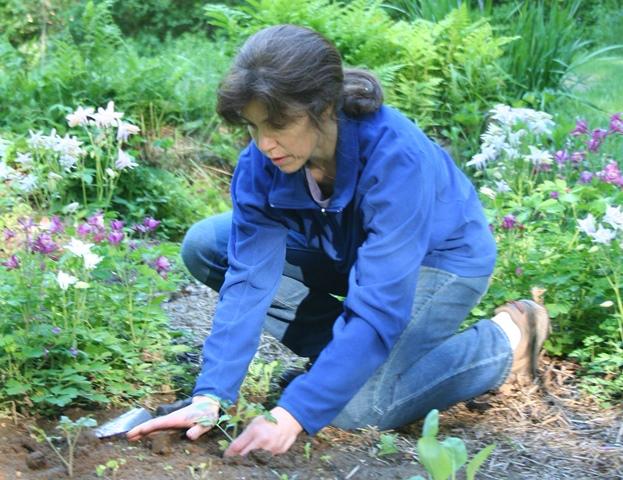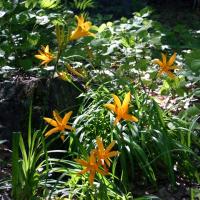In the garden or forest, letting in the light gets things growing
- Tags:
- Working Forests

This garden patch is sunnier now that the shady maples are gone. Forest Society photo.
My backyard wants to be a forest. This is a problem because I want it to be a gardener’s paradise surrounded by forest. Towering maples and birches conspire against me from the yard edges. They hurl their seeds into my gardens so profusely I end up yanking tree sprouts all season long.
“Back! Back!” I mutter to the encroachers.
But the shade is the real problem. For years, I’ve wanted more sun on my garden patch. Without it, flowers and vegetables struggle valiantly, only to end up leggy and leaning together to the southwest as they reach desperately for the afternoon light.
All of that is changing now. It all started when, in utter frustration, I grabbed an ax from the garage and started chopping down one of the shady maples at the forest edge. I only stopped when my husband drove into the driveway and saw his sweaty, maniacal and mosquito-tormented wife wielding an ax. It’s hard to smile sweetly and say, “Welcome home” in that situation.

It occurred to me that this conundrum is a little like the one that forest managers deal with on a much larger scale. Sometimes, people unfamiliar with sustainable forestry assume that all logging is detrimental – the opposite of conserving. When they see private or public conservation lands being logged, they say, ‘Hey, aren’t we supposed to be protecting those forests?’
The answer is yes, and cutting trees responsibly is a practical way of doing so, especially here in the Northeast.
The Northeastern forest is amazingly resilient. As long as it isn’t covered by asphalt, it grows back, fast, on its own with no help from us, and it doesn’t even need to rely on seeds to do it. Stumps work well, too. Just this week I noticed that one of the stumps from a maple tree we cut last fall already has sprouted replacement trees. None of us needs to look far to see evidence for this regrowth from seed and stump. Much of New Hampshire was cleared for farmland until the late 1800s, and just look at us now, the second most forested state in the nation.
I’ve been watching with fascination a similar transformation in the former field next to our place. Our neighbors used to mow it every fall but stopped about three years ago. When I visited last week, the maple, oak and cherry saplings were shoulder-high, and white pines about a foot tall were popping up among the milkweed.
So logging done responsibly doesn’t hurt the forest, and there are many ways that it helps -- while at the same time providing us with wood products from firewood to furniture.
Landowners who own a lot of land can use the money gained from selling timber to pay their taxes and/or provide enough incentive for them to keep the land intact instead of selling it into development for a profit. (The Forest Society is a landowner, too, and the money gained from selling timber from its properties helps the organization conserve more land.)
Timber harvesting is also a useful tool for improving wildlife habitat with “patch cuts.” Patch cuts mimic natural events like ice storms, wind storms and forest fires. All of these events naturally create holes in the forest canopy and allow for sunlight to reach previously shaded areas and new growth to emerge.
Patch cutting is used to replace mature, less diverse forests with grasslands and young forests, which both provide habitat for many species that need it badly here in New Hampshire, like the endangered New England cottontail, American woodcock and many other birds.
Because of people’s aversion to logging and the temporary messiness that comes with it, as well as our suppression of forest fires, our New Hampshire forests are growing mature and homogenous. Old sameness in any realm is pretty boring, but with forests it means less diversity of wildlife and plant life, something we can mitigate with sustainable forestry.
It’s kind of like my backyard. It’s sunnier now that we thinned the crowd of maples. Rather than growing anemic peas and only shade-loving flowers, I’m looking forward to a robust crop of veggies and “full-sun” flowers I couldn’t grow before. I just hope the deer, rabbits and woodchucks will stay in that juicy young forest taking over my neighbor’s former field.
